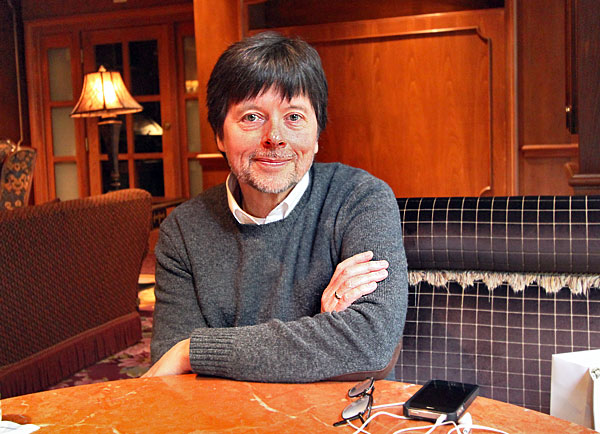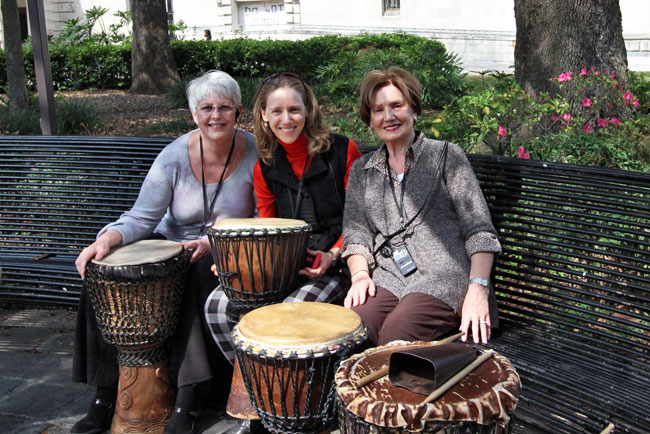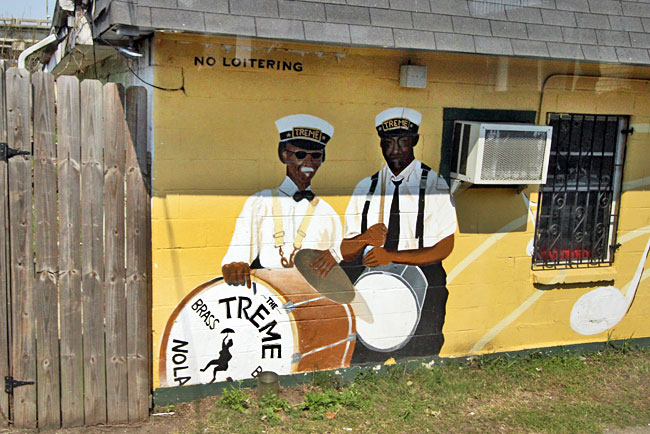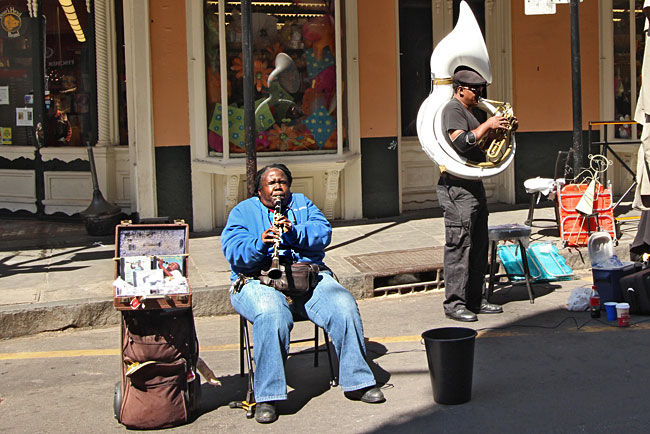Wishes are powerful things. Last year, I wished that I could experience more live music as I travel around the world, learning about other cultures. Like photography and writing, music has the ability to transport me, but traveling perpetually makes it difficult to plan for live performances when I barely know where I’ll be next month. The wish fairy must have heard me, because the following week I received an email from Tauck, inviting me to attend a Tauck Event of my choice. These theme-driven one-of-a-kind tours focus on cultural, historical, nature or sports.
I could have chosen to experience the 139th Running of the Kentucky Derby as a VIP in reserved seating at Churchill Downs or rung in the New Year on their Celebration of Roses Event, complete with grandstand seating for the Tournament of Roses Parade. But one option stood out among the rest, the Tauck Jazz Event, which promised to explore the past, present and future of jazz in New Orleans, the city that gave it birth. Even better, this particular event was being curated by legendary documentary filmmaker Ken Burns, who spent years researching the history of jazz in preparation for his ten-part documentary series for PBS, entitled simply, “Jazz.”

I had always assumed that jazz was birthed in the early 1900’s, when Louis Armstrong was blowing his trumpet and singing scat in the smoky, dark clubs of New Orleans. The true roots of American jazz, however, hail back to the 19th century, to a time when almost every town in the U.S. had a brass band – some more than one. For decades these brass ensembles performed at every public event, ranging from a Fourth of July picnic to a political rally until, in the mid-20th century their popularity had all but died out. But they had planted a seed.
By 1913, a new music was throbbing through the streets of New Orleans. Piano riffs drifted out of the clubs, restaurants and bordellos, accompanied by the bluesy horns of Freddie Keppard and Joe Oliver and the foot-stompin’ clarinet of Johnny Dodd. Youngsters like Sidney Bechet were challenging established musicians to “cutting” contests, a musical challenge intended to establish their reputation and perfect their improvisational techniques. One of these youngsters was Louis Armstrong – Satchmo – who at 12 years old had already mastered the cornet and was playing at the resorts on Lake Ponchartrain with a group of boys from the Colored Waif’s Home. To the musicians of the day these infectious rhythms were “hot” music, a “gumbo” that melded influences from disparate traditions into what ultimately became what we know as jazz. In his keynote address during our tour, Ken Burns explained the remarkable process that created jazz in New Orleans:
“From the complex African polyrhythms that slaves were permitted to play once a week in Congo Square to the call and response of Baptist churches. From the slave songs simmering out in the hot southern fields to the new brass instruments left behind by Civil War soldiers when the war ended, giving musicians here other things to play on. From the Viennese and French operas that dominated the cultural scene of the educated creoles to the Scotch-Irish hymns, folksongs and ballads that bound many early immigrants to this country together. All of this music mixed together, here, in this city. This mixture continued to simmer and came to a boil, here. And it needed one thing. It needed the all-important ingredient, the roux that would complete this gumbo, make it distinct from just another soup, just another stew.
That came in two interesting forms. The first was the wonderful, loud, syncopated, driving rhythm that black piano players created up the Mississippi River, in St. Louis and other towns along the way, that everyone would eventually come to call Ragtime. It was ragged rhythm and a lot of people didn’t know how to deal with it. But they did here. And then finally, out of the Delta, thousands of black Americans suffering from the sins of the Jim Crow era, poured into this then tolerant city, bringing the final, fundamental thing, the je ne sais quoi , the extra ingredient, the real roux in this gumbo. The Blues, a simple, elastic form of personal expression that transformed all of these various elements into that gumbo, crystallized here at the end of the 19th and beginning of the 20th century, to become the music we call jazz.”

The syncopated rhythms of jazz moved up the Mississippi to Chicago, then further afield to New York and California, in the process becoming the soundtrack for America. Soloists like Armstrong became the focus, replacing the collective improvisation of the band at large and leading in the era of Big Bands. By the end of the 1920’s, the golden age of jazz in New Orleans was drawing to a close. Blind to the treasured heritage they could so easily have claimed, the city tore down the “Back of Town” neighborhood, including the house where Louis Armstrong was born and raised. In it’s place rose “an ugly green municipal complex that looked dated when the construction crew walked off the site,” according to our tour guide, Charles Childress. Later, the Treme neighborhood was cleaved by an extension of the Interstate, destroying another historic community where so many New Orleans jazz greats had played in the local clubs.
Danny Barker, a native New Orleanian banjo and guitar player who was in Cab Calloway’s band for a while, returned to the Crescent City in the 1970’s and was appalled by the situation. Hoping to reignite the passion for jazz, he sponsored the Fairview Baptist Church Brass Band, a bunch of young musicians from the Treme neighborhood. Those kids stayed together and became the Dirty Dozen Brass Band, which revolutionized the brass band tradition in the late 70’s. They started using tight horn arrangements and really amped up the speed. More than 35 years later, they are still together, playing around New Orleans.
These days, jazz has seen a significant resurgence in New Orleans. Other brass band followed the Dirty Dozen: the Rebirth Brass Band, which received a grammy last year, has a home stand every Tuesday night at the Maple Leaf Bar. A third band, called simply the Treme Brass Band, came out of the neighborhood. They’re an old style band with a much more traditional sound. One night a week they play at d.b.a bar down on Frenchman Street and every Wednesday night they still play in the hood at the Candlelight Lounge. One of the most instrumental figures in this movement was Lionel Batiste, the original bass drummer for the Dirty Dozen until he joined the Treme Brass Band. Uncle Lionel, as he was affectionately known, died last year and his funeral would have convinced any doubters as to the resurgence of jazz in New Orleans.

When a jazz great passes in New Orleans, brass band musicians walk behind the casket, playing in honor of the deceased. In many cases the family doesn’t pay for musicians to come, especially if it’s someone who is well known or if it’s a musician who’s particularly well thought of. Sometimes 100 musicians will show up and play together. When Uncle Lionel passed, they did not just have a jazz funeral. According to Childress, “It was weeks of parades all over the city – that’s how much of an icon he was. He was a dapper guy, a really diminutive guy. In fact, when they waked him, they had him standing up.” To the end, Uncle Lionel was marching off with his big bass drum.
American essayist and culture critic, Gerald Early, remarked, “When they study our American civilization 2000 years from now Americans will be known for only three things: the Constitution, Baseball, and Jazz Music.” How ironic, then, that jazz has struggled so to stay alive in New Orleans. The brass band tradition languished and it took someone like Danny Barker to revive it. That theme runs through much of the town’s musical legacy, though recently more of an effort has been made to reclaim its jazz heritage. Although Satchmo had nothing to do with either, the city’s airport is named Louis Armstrong International and another portion of the Treme neighborhood was knocked down to install Armstrong Park.

Jazz appeared on the scene before I was born but my mother and father listened to jazz records all through my childhood and my 87-year old father still cranks up the Big Bands whenever he works in the garage. The music of Louis Armstrong, Pete Fountain, and Duke Ellington has always been a part of my life, albeit a part that stood slightly on the sidelines, since I grew up in the era of the Beatles and rock and roll. Or so I thought. Yesterday I struck up a conversation with a couple who happened to be sitting next to me on a bench in St. James Park in central London. When the conversation turned to music, Bob made this startling statement:
“Everyone thinks that the Beatles are responsible for rock and roll, the whole British Invasion thing. But in truth, rock and roll grew out of the music that was being played by American servicemen stationed here during World War II, most of whom were African American. British rock groups went crazy over their blues and jazz and blended it into their own sound.” According to Bob, without jazz, rock music as we know it today might never have been born. I thought about that and remembered Ken Burn’s insistence that “Louis Armstrong is quite simply the most important person in American music.” He may just be on to something there.
Disclosure: I was a guest of Tauck on their Tauck Jazz Event, one of their custom designed once-in-a-lifetime Tauck Events that provide insider insight and access for savvy travelers. However, the receipt and acceptance of complimentary items or services will never influence the content, topics, or posts in this blog. I write the truth, the whole truth, and nothing but the truth.

Cool experience! I went to New Orleans a few years ago, and though not a fan of jazz normally, found myself sitting for hours in some of the many jazz clubs listening to the music, it really is amazing.
Hi Liz: Someone told me recently that they don’t like jazz music and I thought, “they need to hear jazz in New Orleans”….
Loved your write-up of this trip Barbara. I’m a big fan of jazz, but know very little about it’s origins & history. Learned something new today. 🙂
Thanks Matthew – always nice to hear that people not only read what I write, but that they learn something from it 🙂
What a great experience! I was in band when I was a kid and even played in our school’s jazz band for a few years, though I don’t really know much about the history of jazz itself. But New Orleans definitely seems like the perfect place to learn about it!
It is Ali. I don’t think there’s another place in the world more tuned in to jazz – pun intended.
A tour of New Orleans Jazz clubs is one of the things on my “do before I die list”. New Orleans culture is like no other. I’d love to get off the beaten path and see some of the lesser known performers/venues.
Mary, if you go, forget about Bourbon Street. Our Tauck guide told us there were two places to go to hear great jazz. First, in any of the jazz clubs on Frenchmen Street, in the French Quarter; and second, in clubs located in the Treme neighborhood, where the brass band tradition was born.
I am just dying to go to New Orleans. For the music and the food and the watered down french culture:) When and if we do settle down back in North America we might consider New Orleans.
Hi Annie: I thought the same thing – New Orleans might be the kind of town I cold settle down in, if I ever come off the road.
New Orleans is such a special place. Even though I’ve been there a few times I only really learned about this history from watching the Treme drama series. I really hope we get there for Jazz Fest one year.
Andrea, New Orleans is unlike any other city in the U.S. – I’d have to say it’s the most European city in the States for sure. If you get the chance, definitely go for the Jazz Fest some time.
While clearly significant, I’d never thought about the importance of Louis Armstrong to music as possibly the forerunner to virtually all modern music. The Ken Burn’s colourful explanation is simply wonderful – what a picture he paints (” a roux that would complete this gumbo…”)
Hi Mark: Ken Burns has so much knowledge about so many things – he simply amazes me.